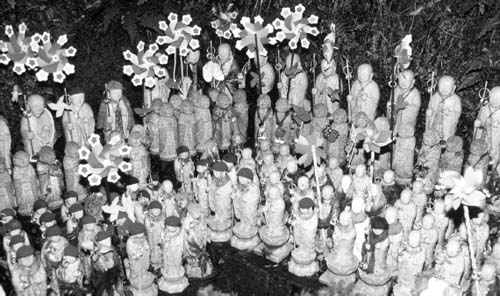BuddhismSigns and Symbols |
Are there any signs or symbols that might identify an individual as a Buddhist? |
In most parts of the world in which Buddhism remains an important presence, it is a safe bet that many people on the street have had some direct contact with Buddhist tradition, but it is usually difficult to tell Buddhists from non-Buddhists merely by looking at their clothing or other personal effects. Occasionally you will spot an item of jewelry whose symbolism is more or less explicitly Buddhist. The eight-spoked Wheel of Dharma is a common symbol easily reproduced on small-scale items. Buddhist pilgrims, however, often stand out because of the traditional garb and variety of symbols they wear. In Japan, for example, some pilgrims wear a large, round, pointed or bowl-like straw hat, carry pilgrim staffs, and wear around their necks a small cloth wallet in which to collect the souvenir stamps they receive from each temple they visit.
Monks, nuns, and priests bear the most obvious examples of distinctive signs. Nearly everywhere in the world, monks and nuns shave their heads. They typically wear a distinctive habit or garb, consisting of two or three wraps—two for novices, three for senior monks and nuns. One wrap covers the lower body, another the upper. For religious rituals, monks wear a long cloth of twelve folds, sometimes called the stole, over the left shoulder. Colors vary according to region and institutional affiliation, from one branch of the monastic order or Buddhist lineage to another. Saffron is the most common color for monastic garb, but, for example, Tibetan monks often wear a dark burgundy, Japanese monks typically don darker shades of gray, brown, and violet, and Chinese nuns often wear a simple gray robe.

A collection of miniature images of the Bodhisattva Jizo, patron of unborn children. Women who have had abortions often purchase the small statues as votive offerings and leave them at certain temples, sometimes adorning them with knit red caps or bibs, along with pinwheels and other toys.
